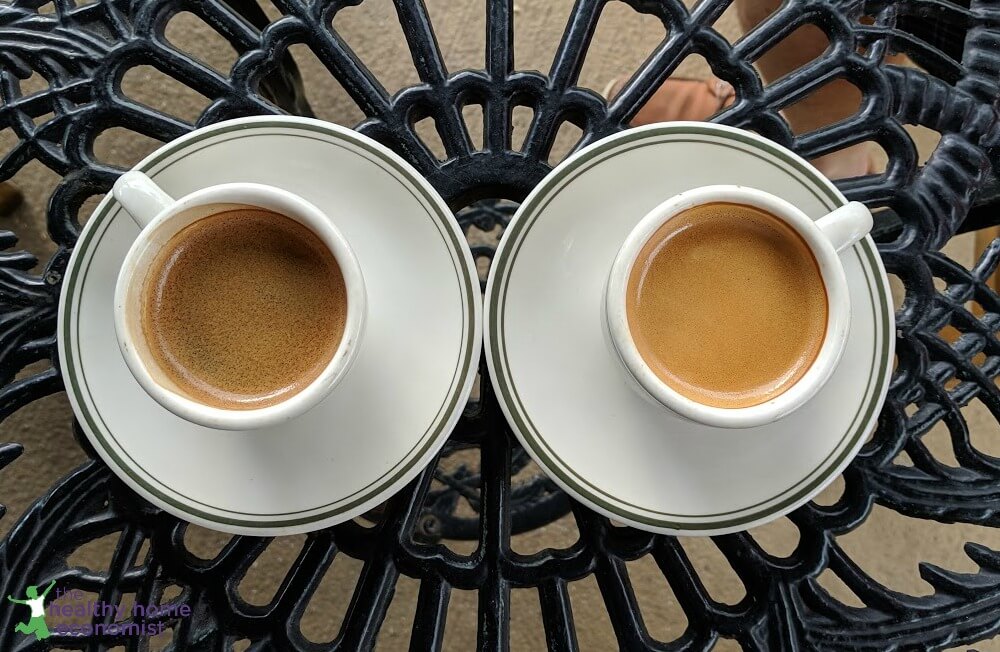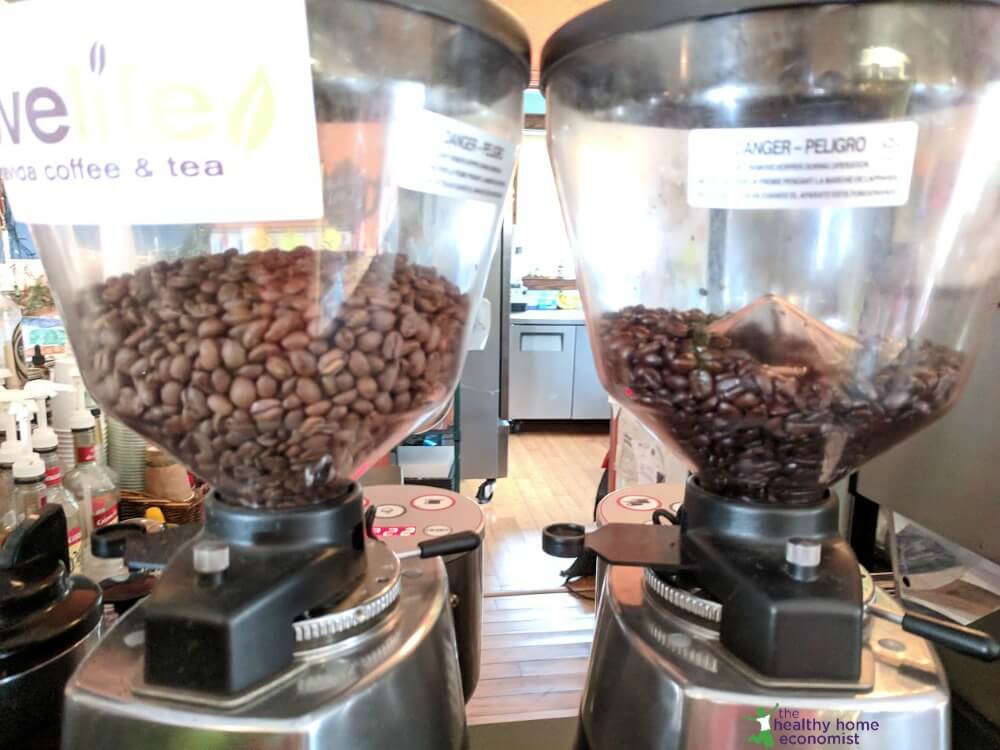
In our stressed out/sleep deprived culture, daily caffeine consumption can be a risky practice. The potential for developing an addictive habit is very real.
Visual symptoms such as deep lines/creases in the cheeks, balding lower legs, or lines in the fingertips may eventually appear. Fatigue and sensitivity to bright sunlight are other common adrenal fatigue symptoms from caffeine overconsumption.
Lifestyle guru Tony Robbins is reportedly so against caffeine – ever – that he dives into a cold swimming pool every morning to wake up – an interesting counterpoint to the bulletproof coffee narrative.
It seems to me that neither of these extremes is a desirable way to live. An occasional cup of coffee or shot of espresso is not such a terrible thing that it needs to be banished from your life forever providing there is no history of a tendency toward addictive behavior. (1)
When enjoyed in moderation, it can be a nice treat much like the odd dessert to celebrate a special occasion.
I myself do not drink coffee, but do enjoy a shot of espresso from time to time when out for a celebratory event.
If you are an occasional coffee or espresso fan too, have you ever wondered which is the best choice – blonde (light) or dark roasts?
Here’s what I found out. Is the one you prefer the best choice?
Light vs Dark Roast Espresso
Visually speaking, light roast coffee beans are easily distinguishable from dark roast. See the picture below where the blonde roast on the left is significantly lighter in color.

Caffeine Content
Some people believe that dark roast coffee contains more caffeine because it is stronger tasting. Others believe light roast contains more because the longer roasting process for dark beans eliminates more of the caffeine.
The truth is that caffeine if affected very little by the roasting process, which rarely exceeds 470 °F/ 243 °C. Any significant variation would require a roasting temperature above 600 °F/ 315 °C. As a result, a coffee bean’s caffeine content remains relatively static no matter what the roast level. (2)
What does change during roasting is the size of the beans. See in the picture above how the light roast beans are different in size from the dark roast beans. This is because the dark roasting process eliminates 90% of the water in a coffee bean. This variation in size causes the caffeine content to fluctuate depending on whether you measure the beans by volume or by weight.
If you measure your coffee by scoops, light roasted coffee will have more caffeine. Since the beans are denser than a darker roast. However if you weigh out your scoops, darker roasts will have more caffeine, because there is less mass. (3)
Thus, do not choose a dark roast over a light roast (or vice versa) strictly based on caffeine content. The amount between the two will vary a bit, but not by a lot.
Taste
If you sipped the two cups of espresso in the picture above, you would notice a stark difference in taste.
Light roast espresso is quite sour with a strong lingering aftertaste. If you enjoy eating unripe bananas, you probably find it appealing.
Dark roast espresso is much richer tasting and distinctly more bitter with little to no sourness.
The first time I (unknowingly) tried a light roast espresso, it was so sour I thought it had gone bad! Finding the taste completely repelling, I actually tossed it after a few sips.
Ultimately, there is no better or best when it comes to the taste of light roast vs dark roast espresso or coffee. Choose the one that suits you taste buds.
Acrylamide
One of the most notable differences between light and dark roast coffee is the amount of acrylamide each contains.
What is acrylamide? It is a carcinogenic substance that is created when starch is roasted, fried or otherwise heated.
While the risks are certainly low if you consume coffee or espresso only occasionally, it is still important to note the differences in the amount of acrylamide between blonde and dark roasts.
While acrylamide is created during the coffee bean roasting process, it peaks quite early and then begins to decline. As a result, light roast coffee beans surprisingly contain significantly more acrylamide than dark roast beans. This is the case despite the longer roasting time. (4)
A significant negative correlation was observed between acrylamide levels and the intensity of colour in roasted coffee …. (5)
Coffee is recognized by scientists as a principal dietary source of acrylamide where, in many countries, it is consumed daily and in significant amounts. (5) In those cases, it is best to choose dark roasts to reduce acrylamide exposure.
If you only consume it once in awhile, the occasional light roast is likely not a big deal if that is what you genuinely prefer.
If you enjoy both, choose the dark roast!
Antioxidants
The biggest health benefit of coffee is arguably due to the high levels of antioxidants.
But which has more antioxidants, light or dark roast?
Scientists have examined this very question and the answer is once again surprising. Dark roast is better than light roast!
While it seems logical that light roast coffee beans would have more antioxidants since they aren’t roasted for as long, this did not prove to be the case in the research.
The journal Molecular Nutrition and Food Research published a study which found dark roast coffee restored blood levels of the antioxidants Vitamin E and glutathione better than light roast. (6)
Dark Roasts Easier to Digest
According to research published by the Journal of Agricultural and Food Chemistry, dark roast coffee may be easier on your stomach. This is due to a the chemical N-methylpyridinium, which is produced during the roasting process. The longer the coffee beans are roasted, the more N-methylpyridinium they contain. (7)
N-methylpyridinium appears to prevent stomach cells from acid overproduction. Thus, if you tend to experience stomach irritation or acid reflux from drinking coffee, a darker roast is likely the better choice.
So Which is Better? Blonde or Dark Roast Coffee?
In sum, while the caffeine content of various roasts is not significantly different, dark roasts do seem to be the better choice overall.
Dark roast coffee and espressos win the day by offering much less acrylamide per serving along with a heftier dose of antioxidants. Combine these two pluses with less risk for stomach irritation and you have a dark roast slam dunk.
Many thanks to Jessica of Jet City Espresso Cafe in Seminole Heights, Florida for sharing with me her decades worth of knowledge on this subject! If you want a good espresso that is organic and fairtrade, check out this locally owned business!
 References
References
(1) Genetic influences of addiction
(2) Which has more caffeine: dark or light roast coffee?
(3) Caffeine Myths: Dark vs Light
(4) Acrylamide in Coffee: Should You Be Concerned?
(5) Studies of acrylamide level in coffee and coffee substitutes
(6) Dark roast coffee is more effective than light roast coffee in reducing body weight, and in restoring red blood cell vitamin E and glutathione concentrations in healthy volunteers
(7) Activity-Guided Fractionation to Characterize a Coffee Beverage that Effectively Down-Regulates Mechanisms of Gastric Acid Secretion as Compared to Regular Coffee








Hallelujah! I LOVE Dark Dark Dark… but was always worried that less roasted was the healthier choice.
I don’t have any comment yet because I just found out about you in a daily E-mail I get from “Sarah the Healthy Economist”. I do however want to sign up for your newsletter. Is it sent in an E-mail format.
I’ve naturally weeded out the coffees that don’t sit well with me, and whaddaya know, I only enjoy dark roast coffee. I buy locally grown cuban style dark roast and I grind it really fine and use alkaline water to brew it to further cut out any acidity. The result is a very smooth, virtually no bitterness, and enjoyable cup of coffee.
Is this true of regular light roast coffee also? I don’t drink espresso.
Espresso and regular coffee are both made from coffee beans … either light or dark roast. So yes, light roast coffee would be included.
Thank you for this informative article. I wish you also touched on regular vs. decaffeinated coffee. I usually drink only decaf coffee and I do it for enjoyment and not to keep me awake.
Barbara said it all, totally agree! I love getting your info and you do it all very well!
Big Thank You!!
This may be a stupid question but does this apply to regular coffee also? I would assume so, but would like some feedback. I prefer regular roasts to espresso.
Yes, it applies to regular coffee also 🙂
I limit myself to only a couple of cups of coffee per day. I love brewed dark roast coffee with no cream or sugar added. I tried the light stuff once. To me, it was horrible. The bitterness was overpowering and there was no coffee flavor at all. I took two swallows of it and dumped the rest. Dark roast does not upset my stomach the way the light stuff does. That’s what the difference means to me. BTW, I already get your newsletter–very interesting content.
Well good for Tony Robbins for his holier-than-thou ability to avoid caffeine by diving into an unheated pool at his home in Palm Beach. If only all of us could be so fortunate. Yet, I have the pleasures of coffee instead, like the rest of us who live in northern climes. Coffee is so much more satisfying after a cold dip, actually. So I do both! So of us are more sensitive to caffeine than others. Perhaps Tony Robbins is among the caffeine-sensitive. I do fine with it in moderation.
Sarah,
I SO appreciate the wealth of knowledge and curent research you share, as well as product ideas related to your articles.
Even more than the excellence of your Newsletter, I TRULY appreciate that you don’t over-send/bombard our email boxes.
You send an amazing amount of qualtiy information, in each Newsletter, rather than sending “snippets” on a daily basis!!
(and they come much less frequently than once p/week!)
You present yourself as not only highly well versed in this content area, but because you share so much, in such a limited amount of emailing, it demonstrates your true professionalism and sincere dedication to honestly and earnestly get this vital information out to the masses.
Thank you for all the qualtiy work you put into your Newsletter and making it so easily and comfortably available to us all!
Barbara C. Colorado 2/04/2019